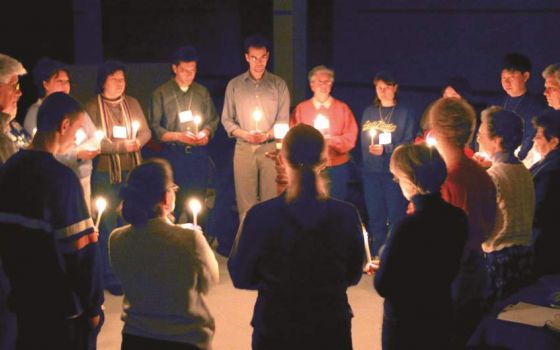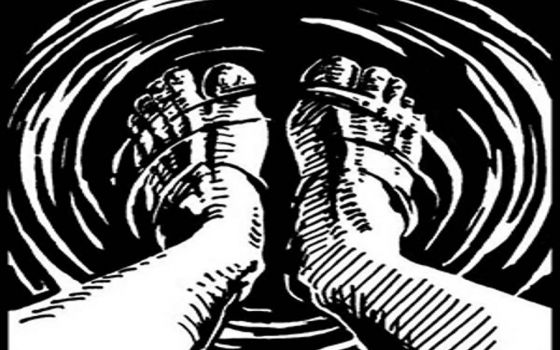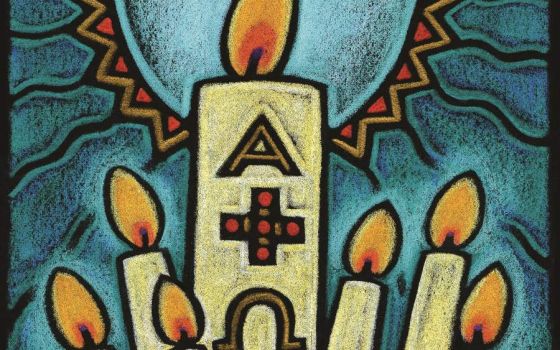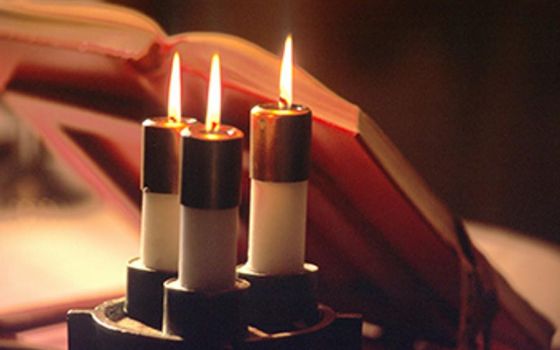Lent ends at sundown on Holy Thursday, and the church pulls out all the stops. The symbols and rituals that we use on various occasions throughout the year take center stage as the Easter mysteries unfold. Their depth of meaning can never be exhausted; layer upon layer gets peeled away as we play and revel in awe-inspiring ceremony. The wonder is created by the symbols that are used each time we gather.
The following are some of the major symbols used during Triduum, along with their accompanying ritual gestures:
- Assembly................ Gathering
- Water..................... Immersion
- Light............................ Passing
- White Garment.... Putting On
- Cross........................... Signing
- Oil............................ Anointing
- Touch..... Laying on of Hands
- Salt............................. Pouring
- Bread & Wine Breaking/Pouring*
- Eating/Drinking
*During the Fraction Rite, Christ's body is once again broken, his blood poured out for us who beg for mercy and peace. The current practice of pouring the wine into cups during the preparation of altar and gifts theologically makes no sense, thanks to Redemptionis Sacramentum.
These common, everyday elements are brought to life through words and gestures that point to much deeper realities. Their significance will be as unique as every individual experiencing them. Our responsibility is not to explain them, but rather to set them out with vivacity and energy. People are free to make their own connections.
The liturgy culminates with the Easter Vigil, which begins with the blessing of the fire, the lighting of the Paschal candle and the singing of the Exultet. This ancient text, one of the few that comes to us from the early church, is eloquent in its articulation of God's profound love for us. This ancient hymn compels us to "Rejoice!" Unrestrained wonder and elation are contagious — we can't help but "join in the dance!"
Advertisement
Night truly blessed
when heaven is wedded to earth
and humanity is reconciled with God!
—Exultet
Sacred liturgy is the bridge between heaven and earth — we step out of time and space as we know them here in the physical world and into eternity. Through ritual expression we glimpse heaven and remember where we came from and where we are going. Heaven and earth are no longer separate realms, but one and the same. We encounter the peace, reconciliation and ultimate freedom that are ours through the grace of baptism.
Now our shame becomes our glory on this holy tree.
Now the reign of death is ended. Now we are set free.
—Dan Schutte, "Join in the Dance"
The Exultet is filled with rich imagery centering on darkness and light. Christ is the "Morning Star which never sets, who came back from the dead, and shed his peaceful light on all humankind." We are indeed dancing with the stars!
Editor's note: This reflection was originally published in the April 2011 issue of Celebration. Sign up to receive daily Lenten reflections.
The Easter Triduum — it is the Mirror Ball Trophy of the liturgical year. Sunday after Sunday, season after season brings us to this moment. It is the celebration of the Paschal Mystery, and we have been gearing up for it all year. As the Dan Schutte song goes, we are called to "join in the dance of the earth's jubilation [for] this is the feast of the love of God."
Though I am not a weekly devotee of "Dancing with the Stars," I must admit I am impressed by the hard work, energy and careful attention to every detail pursued by the contestants. They perfect crucial elements such as timing, balance and sequence, making it appear effortless and even fun. Partners are confident in themselves and one another. Having ironed out all the wrinkles behind the scenes, the dancers offer up their best.
The connection here to liturgical preparation is obvious: The dance that is the sacred Triduum must be just as carefully choreographed and executed. There is one liturgy, celebrated over three days beginning with the Evening Mass of the Lord's Supper on Holy Thursday. There is no final blessing or dismissal as we conclude in silence and vigil. There is no opening prayer or greeting on Good Friday, nor is there final blessing and dismissal. The prayer continues.
This liturgy insists on hospitality at its finest — nothing short of our very best! Musicians, cantors, lectors, servers, presiders, preachers all contribute to the movement and elegance of these days only after careful, prayerful preparation. This liturgy is anything but "business as usual," as the order of worship we are accustomed to working with each week is disrupted by rites we use only once a year. These rites demand attention, requiring time and communication regarding every detail. Rehearsals provide a wealth of opportunity for learning, growth and deepening spirituality for all involved. Liturgies that are well-prepared and ministers who know what they are doing and why communicate a confidence and ease that enables the assembly to relax and enter into the prayer.






